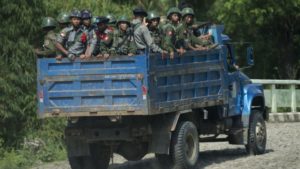
The military launched an anti-terror operation in Rakhine state in October
The UN has strongly criticised the government of Myanmar over its treatment of the minority Rohingya Muslim population.
The UN’s Human Rights Office said it was receiving daily reports of rapes, killings and other abuses.
Human rights chief Zeid Raad al-Hussein said the government approach was “counterproductive, even callous”.
At least 86 Rohingya have been killed and more than 27,000 forced to flee military operations in Rakhine state.
The government of Myanmar, also known as Burma, says it is conducting counter-terrorism operations in the region but has denied reports of atrocities.
Most of the displaced Rohingya have fled across the border into Bangladesh.
Who will help Myanmar’s Rohingya?
“The repeated dismissal of the claims of serious human rights violations as fabrications, coupled with the failure to allow our independent monitors access to the worst affected areas in northern Rakhine, is highly insulting to the victims and an abdication of the government’s obligations under international human rights law,” Mr Hussein said in a statement.
“If the authorities have nothing to hide, then why is there such reluctance to grant us access? Given the continued failure to grant us access, we can only fear the worst.”
A spokesman for the UN refugee agency (UNHCR), Adrian Edwards, said his colleagues in Bangladesh had heard accounts of abuses from Rohingya refugees. They included traumatised women and children who had witnessed the killing of family members.
He said the UNHCR could not verify the accounts but it was extremely concerned.
Independent journalists have not been allowed into northern Rakhine since armed militants attacked border posts in Maungdaw on 9 October, killing nine policemen.
The Myanmar government, which is led by Nobel Laureate Aung San Suu Kyi, has faced international criticism over the situation there.
Earlier this week, Human Rights Watch (HRW) said new satellite imagesestablished a link between the military and the burning of Rohingya villages.
HRW says analysis of the images proves soldiers were in the area
Image copyrightHUMAN RIGHTS WATCHImage captionHRW says analysis of the images proves soldiers were in the area
It said the images showed military trucks were active nearby when the village of Wa Peik was being burned in November.
The government would not comment on the HRW report but said a team had been sent to the affected villages and its findings were expected to be released at the end of January.
Who are the Rohingya?
The estimated one million Muslim Rohingya are seen by many in mainly Buddhist Myanmar as illegal migrants from Bangladesh. They are denied citizenship by the government despite many having lived there for generations.
Communal violence in Rakhine state in 2012 left scores dead and displaced more than 100,000 people, with many Rohingya still remaining in decrepit camps.
They face widespread discrimination and mistreatment.
Hundreds of thousands of undocumented Rohingya are estimated to live in Bangladesh, having left Myanmar over decades.
